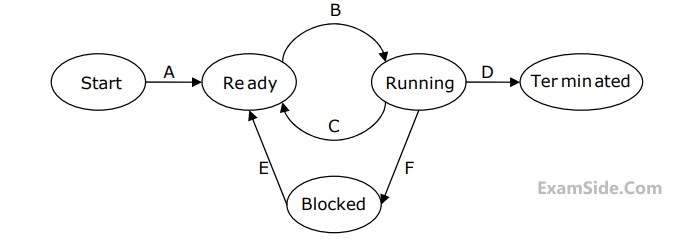| Process Name | Arrival Time | Execution Time |
|---|---|---|
| A | 0 | 6 |
| B | 3 | 2 |
| C | 5 | 4 |
| D | 7 | 6 |
| E | 10 | 3 |
Using the $$shortest$$ $$remaining$$ $$time$$ $$first$$ scheduling algorithm, the average process turnaround time (in $$msec$$) is _______.
| Process | Arrival Time | Time Units Required |
|---|---|---|
| P1 | 0 | 5 |
| P2 | 1 | 7 |
| P3 | 3 | 4 |
The completion order of the $$3$$ processes under the policies $$FCFS$$ and $$RR2$$ (round robin scheduling with $$CPU$$ quantum of $$2$$ time units) are
| Process | Arrival Time | Burst Time |
|---|---|---|
| P0 | 0 ms | 9 ms |
| P1 | 1 ms | 4 ms |
| P2 | 2 ms | 9 ms |
The pre-emptive shortest job first scheduling algorithm is used. Scheduling is carried out only a arrival or completion of processes. What is the average waiting time for the three processes?

Now consider the following statements:
$$1.\,\,\,$$ If a process makes a transition $$D,$$ it would result in another process making transition $$A$$ immediately.
$$2.\,\,\,$$ $$A$$ process $${P_2}$$ in blocked state can make transition $$E$$ while another process $${P_1}$$ is in running state.
$$3.\,\,\,$$ The $$OS$$ uses preemptive scheduling.
$$4.\,\,\,$$ The $$OS$$ uses non-preemptive scheduling.
Which of the above statements are TRUE?